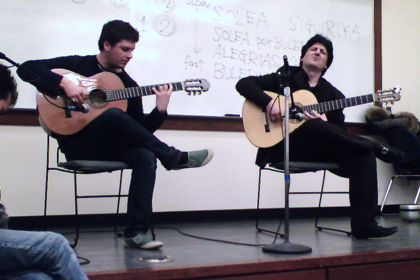Juan Cañizares is a prolific flamenco guitar soloist and collaborator and a professor of flamenco guitar at the Catalonia College of Music.
Cañizares is also a phenomenal player and virtuoso by any measure. At the time of this lecture demo, he was touring with a small troupe performing his arrangement of Isaac Albéniz’s Iberia suite, which was originally composed for piano.

Cañizares on Formal Education
Cañizares’s response to the frequent claim that classical music (and classical music education) will somehow “taint” flamenco, is refreshing – and provides a bit of encouragement for those of us not of Andalusian extraction. Here’s some of what Cañizares had to say on the topic in an interview with esflamenco.com:
The prestige given to ignorance has been very bad for flamenco. Flamenco is a cultured music and it should be seen as such. It can't continue to be associated with nightlife, taverns and partying. It should be taken seriously, professionally. . . . Learning formal music isn't going to make you any less flamenco, to the contrary, it's going to allow you to go further and do things like the Iberia suite. . . . Learning is very important. You can have inspiration but if you are also a professional then you can make more of that inspiration. Doing things without tools is not the same as doing them with tools.
This point of view provided a counterpoint to the first artist presented in this lecture series, Juan del Gastor, who embraces a distinct flamenco gitano style. Fierce advocates for each camp will likely continue to duke it out on the internet for years to come, but I like the idea that these two categories need not be mutually exclusive, that the advent of one does not necessarily portend the demise of the other. Perhaps that such tension is even necessary for an art form to remain vibrant.
Audio Clips
The demonstration portion of Cañizares’s presentation was divided into two sections. The first provided an overview of the main flamenco palos, and the second included longer works and original compositions.
The short clips from the first part of the demonstration provide a good impression of Cañizares’s toque (guitar playing):
Solea
Siguiriya
Solea por Buleria
Alegria
Buleria
In the second part of the presentation, Cañizares played three longer pieces with Juan Carlos Pastor, his accompanying guitarist on the Iberia tour. These songs have more of the “modern flamenco” feel for which Cañizares is better known:
Alegria de Cañizares
“Lejana” (Balada)
“Lluvia de Cometas” (Rumba)
I find it interesting to listen to these compostions in juxtaposition with Cañizares’s more traditional toque. Even though these clips are in a largely non-traditional style, Cañizares’s “voice,” as with the clips above, is clear throughout.
See Part One: Juan del Gastor
This lecture demo was part two in a two part series put on by the University of Washington’s Depertment of Spanish. Part one, with Juan del Gastor, covers the flamenco traditional, flamenco gitan style of Morón de la Frontera.

